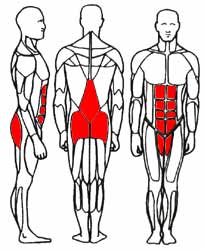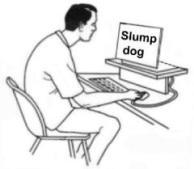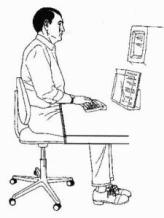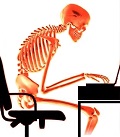
Thereís an epidemic of musculo-skeletal dysfunction in the sit-down industries Ė and thatís not just offices it includes people driving graders, bulldozers, vans, trucks and buses Ö
It is also frequently the case that staff members are neither strong enough nor flexible enough to keep themselves in a good sitting posture for long periods of time. The net effect of years of poor sitting posture is musculo-skeletal dysfunction, particularly of the lower back, shoulder and wrist.
Youíd have to scratch your head and ask, ĎHow can anyone injure themselves sitting in a cage several metres square?í
Of course you canít. Itís impossible. Joint and muscles pain that develops when sitting in 'the cage' can be better described as a personally-generated musculo-skeletal dysfunction, not and accident or an injury.
As muscles become tighter the skeleton moves out of alignment. Bearings (joints) wear out.
A lack of strength means you can't keep your arms out in front of you for long periods of time without experiencing muscle pain.
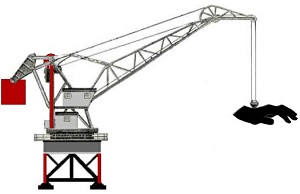
So who (or what) can you blame?
BLAME SITTING DOWN? Ė nope
Itís hard to sheet home the blame for lower back pain on sitting down.
Spend more of your time standing up. If you don't have a desk that moves from the sitting height to the standing height, get a box to put your keyboard on.
What most people donít factor into the sitting down equation is that they need to do some physical training to stop their bodies wasting away.
No train = more pain |
BLAME A LACK OF STRENGTH AND FLEXIBILITY Ė you betcha
|
Without a strength and flexibility training program, the muscles supporting the skeleton gradually become weaker and tighter.
The bones move out of alignment. The muscles arenít strong enough to perform even the easiest of tasks, like tapping a key board, moving a mouse or lifting a ream of paper without breaking down.
Here are three pictures of muscles designed to keep your vertebrae in correct alignment. If theyíre not getting stronger theyíre getting weaker. I can assure you they donít get stronger sitting down.
If youíre going to sit in a chair all day, here are some of the muscles you need to strengthen.
|
|
Most people are not strong enough to sit in a chair for long periods of time without becoming dysfunctional. They canít do a sit up or a pressup. They canít squat down with their bottom halfway between their knees and the floor. They arenít game to do a superman back arch.
They can't touch their toes: they can't sit up straight with their legs crossed and hands clasped behind their back.
If you sit in a chair for 20 years, your calf hamstring and buttock muscles tighten up and tilt your pelvis back. The bones in your spinal column get pulled out of alignment. You end up with a back pain.
BLAME THE CHAIR? Ė doubtful
It is interesting to note that the chair is frequently blamed for a musculo-skeletal incident, one which can only be prevented and fixed by the person becoming stronger and more flexible.
OK, you need the right chair, set up at the right height and with the back rest in the right position to support your body in the ideal sitting position.
But even in the Ďrightí chair, what counts is how you sit in it and whether your calf, hamstring and buttock muscles are loose enough to allow you to maintain the proper ĎSí shaped, sitting-up-straight alignment of your spine.
My advice is to lock yourself in so the back of the chair is pressing into the small of your back and the desk is pushing in to your abdomen.
On top of that you need strong postural muscles to enable you to sit in an ergonomically safe position for long periods of time. Thatís where situps, pressups, squats and Superman fit in.
|
In the Ďslump dogí diagram opposite, the back of the chair isnít giving the pelvis and vertebrae the support they need. It is not pushing up under the shoulder blades. The abdomen is a long way from the desk.
This fellow is heading for a disaster. Heíll complain to his boss about his back and neck pain. His boss wonít have a leg to stand on because he or she didnít -
1. teach the fellow how to sit up straight, with abdomen pressing into the desk all the time
2. insist the fellow sit in a proper typistís chair |
The classic Ďslump dogí posture, leading to the classic back, neck and shoulder pain. |
|
The ideal sitting position is with the back of the chair pressing in against small of your back and the desk pushing into your abdomen.
Youíre locked in.
In the long run itís muscle strength and flexibility, and sitting locked in by your chair and the desk which will protect you from a pelvis which tilts backwards, a back thatís lost itís natural íSí shaped curve, slouching shoulders and poking head that lead to lower back pain, neck pain and RSI.
Despite the best intention of your mother and primary school teachers, itís impossible to sit up straight for long periods of time unless your stomach and back muscles are strong, the muscles attached to the pelvis (and lower down) are flexible, the back of the chair is upright and your abdomen pressing in to the desk. |
Locked in and sitting up straight. |
We recommend a variety of sitting, kneeling and standing positions to break up the day and improve posture.

Balans Chair
|
Spend sometime each day sitting on a Balans Chair.
The reason the Balans chair works to correct spinal misalignment is because it takes the effect of tight hamstring and buttock muscles out of the sitting equation. You can sit up straight with a natural ĎSí shaped curve in your spine.
My advice is not to sit too long at a time in this position. Some people find that they get sore knees.
|
|
|
Sit on the floor I know itís not fashionable, but you could spend some of your day sitting on the floor.
When a major cause of back, neck and shoulder pain is tight hamstrings, sitting down on the floor with your legs straight out will gradually lengthen them.
If you can bring in a small coffee table you can prop it over your legs and do some writing and phone-calling as well.
Set your office up so it suits you and your body. Sit down, stand up, sit on the floor, use the Balans chair, go for a ten minute walk, slip the headphones on and relax off for 5 minutes, do 10 minutes of stretching and strengthening, go to a yoga class Ö |
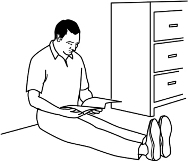 |
It is frequently the case that the chair and the desk are not set up to give good support to the hips and spinal column, thereby placing the staff member at risk.
Here are a couple of tips from Tijana Sefic Ė
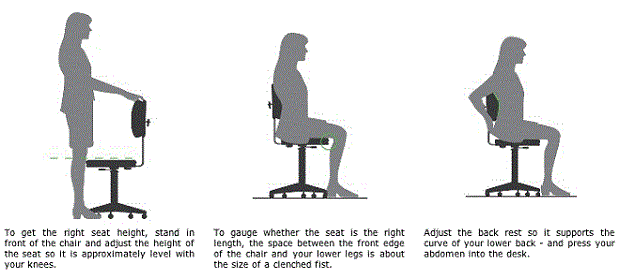
Over use or under use
At first sight, sitting down and typing all day looks like a pretty cushy job. However, if anyone spends long periods of time sitting down and donít have a regular strength and flexibility program, the muscles on the back side of the lower part of the body become shortened, the pelvis tilts back, the shoulders come forward and they end up with lower back, shoulder and wrist dysfunction. The blame is unfairly sheeted home to the employer.
HERE'S WHAT WE DO
Whatís unique about our workstation assessments is that we
|
|
adjust the seat, the desk and the monitor to give people the best possible ergonomic sitting position |
|
|
|
|
|
teach people how to sit up straight |
|
|
|
|
|
provide people with an assessment of the risk they are running of becoming a victim of musculo-skeletal dysfunction due to poor posture and lack of strength and flexibility. |
IN A NUTSHELL
What we do is make sure the:
|
|
desk, the chair, keyboard, and monitor are set up correctly |
|
|
|
|
|
person is sitting up straight, abdomen touching the desk and back of the chair upright and pressing into the back |
|
|
|
|
|
work area is clean and tidy |
|
|
|
|
|
people are sitting their workstation in a way thatís courteous to their work colleagues. |
We make recommendations on the need to get a new chair or a desk of an appropriate height for the person sitting at it.
So who are you going to blame?
DOWNLOAD the Sit-up-Straight work station manual containing some of the key exercises you need to do to keep your body in good alignment and strong enough to keep it functioning normally while doing a job that, from the outside looks like it's pretty cushy.
sit-up-straight_work_station_manual.pdf
